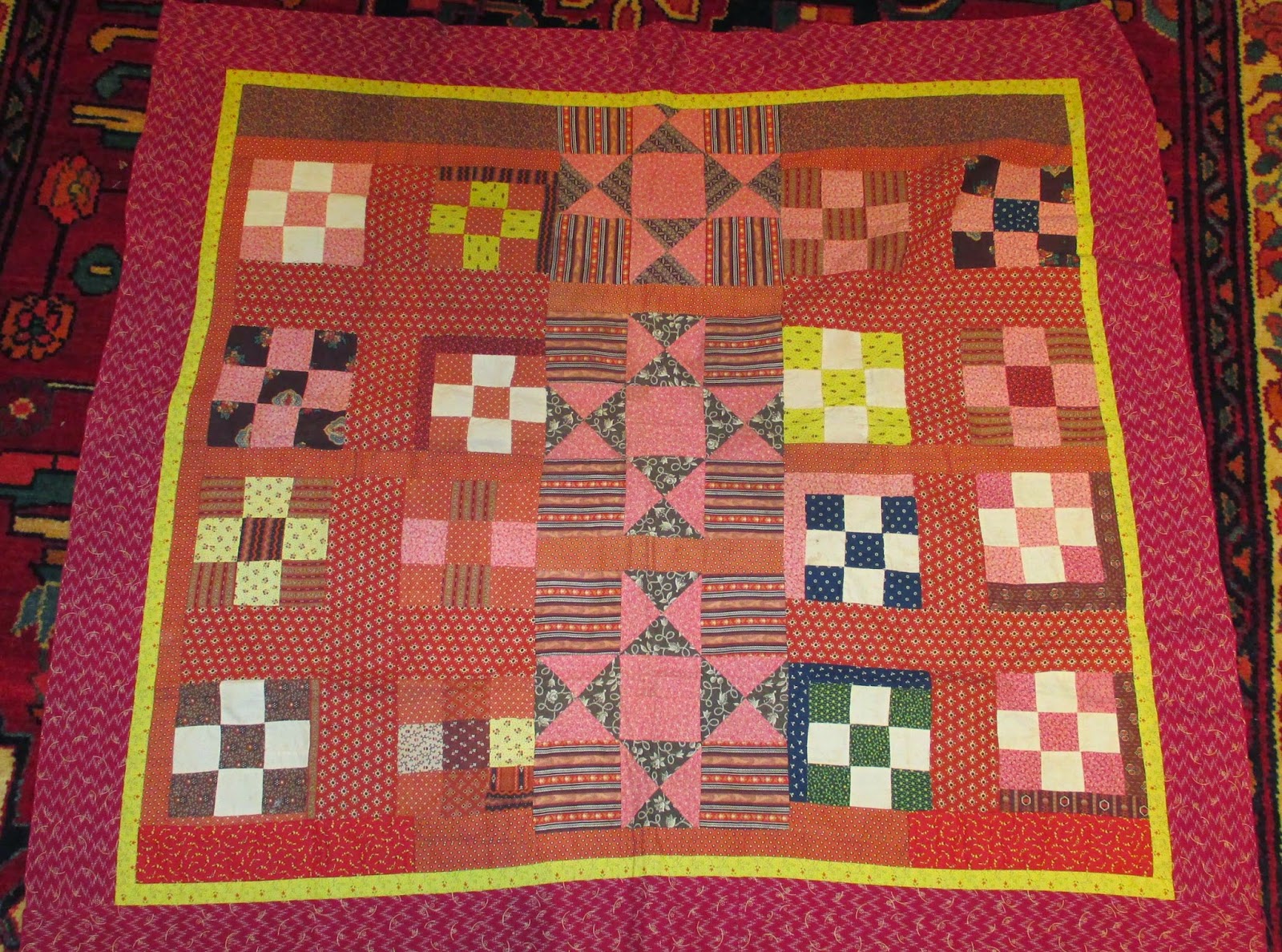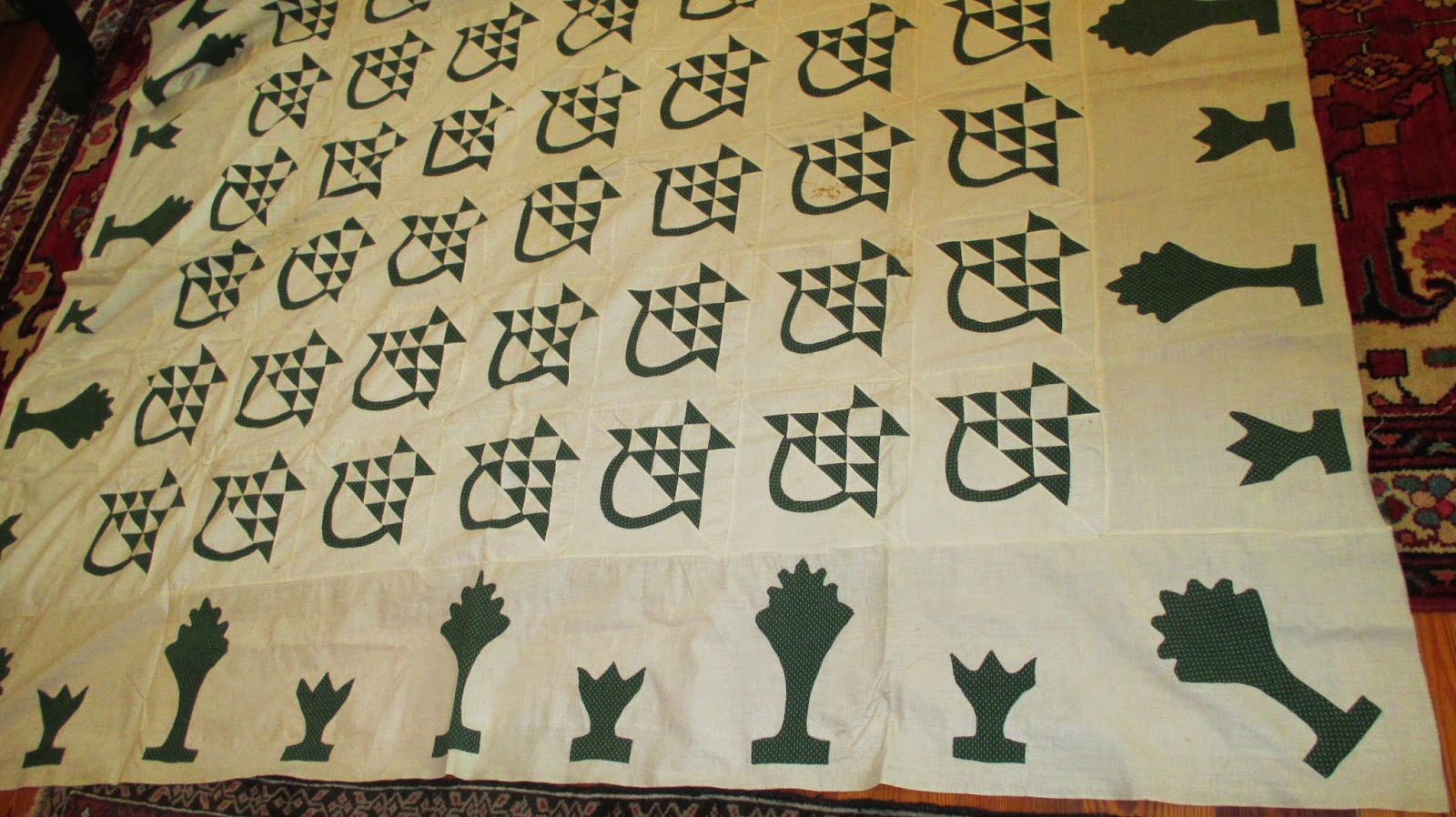The Mystery Quilt of The Orson Starr House
My Mother's Day visit to the Orson Starr House of Royal Oak, MI made my day when I saw a very interesting quilt.
A second floor bedroom displays this pieced quilt. It was noted as made about 1900 by Anna O. Greene of Royal Oak. The sign said she lived at 325 W Harrison in Royal Oak and in 1928 moved to Texas and gave this quilt to Helen Clees, whose daughter Elizabeth inherited the quilt; Elizabeth donated it to the Royal Oak Historical Society.
The quiltmaker's use of fabric is just wonderful. With only two fabrics she has given the illusion of a more complicated quilt.
I thought it was much older than 1900 and shared the photo with the Facebook group "Quits-Antique and Vintage." Quilt appraiser Teddy Mc Mahon Pruett and quilt collector and quilt maker Pepper Cory agreed that the quilt was closer to 1845 than 1900.
Detail of print
The stripped center blocks are composed of a square of Prussian Blue ombre printed fabric. The same fabric plus a solid light fabric is used in the pieced Wild Goose Chase sashing. Prussian Blue was popular between 1830 and 1850, especially in ombre prints.
Ombre is French for 'shaded', referring to the gradual shading of color; here the dark blue fades into a lighter version; a beige and blue print appears between the blue stripes. The print seems to have a floral motif. That part of the fabric is badly decaying, likely because the brown dye used included minerals that have eaten away the fabric. Read more about ombre prints at Barbara Brackmans' post here.
The blocks are bordered with pieced Wild Geese. You can see another quilt in this pattern at Tim Latimer's log post here. and samples at The Quilt Index here and here. This type of quilt block is called Sash and Block.
Learn more about Prussian blue fabrics at Barbara Brackman's Civil War Quilts blog post here and her blog Material Culture here; look at the second antique fabric sample for another Prussian Blue stripe. According to Roderick Kiracofe in The American Quilt Prussian Blue, or Lafayette Blue, was a mineral dye first used in America in 1832. Brackman notes the dye formula was developed in 1770.
The quilt bock pattern is a Wild Goose Chase variation. Kiracofe also writes that pieced quilt patterns became commonplace during the second quarter of the 18th c, including Wild Goose Chase.
The quilt is beautifully hand quilted. Cotton batting can be seen under the decayed parts.
Who Was Anna O. Greene?
I went to Ancestry.com to learn more about Anna O. I discovered her husband was Orville W. Greene.
On March 20, 1862 Orville W. Greene, age 21, enlisted as a private in the army and was in Company 1, Michigan 16th Infantry Regiment and mustered out July 8, 1865 at Jeffersonville, IN. He appears on an 1890 veterans list.
In 1870 Orville W. Greene appears on the Ann Arbor, MI census boarding with a chemistry professor and attending university. He attended University of Michigan in 1869-70 but did not receive a degree.
On October 16, 1872 Orville, age 28 and born in Hulla, MI, and Anna O. Wright, age 20 and born in Wrightstown, WS, were married in Greenville. Orville was a banker.
Orville and Anna appear on the 1880 Greenville, Montcalm MI Census. Anna, age 28, and Orville, 36, had children Mabel, age 6, and a two month old unnamed son. Orville was a "jeweller" [sic].
The 1900 Census of Greenville, Montcalm, MI shows they lived at 510 Clay. Anna was born January, 1853 in Wisconsin. Orville W. was born February 1845 and was a bookeeper. They had children Otto, born January 1878, and Edwin W., born October 1883. A sister-in-law Ida E. Abbot, born October 1856, and a domestic servant lived with them.
The 1920 Census shows that Orville, 77, and Anna, 66, Ida, 63, and grandson Willoughby,11 were living together.
By 1924 Anna and Orville had moved to Royal Oak.
By 1930 Anna, 77, was living in Royal Oak with her son Otto, 52, who worked in an auto plant.
Anna's death certificate shows she was born January 23, 1853 in Wisconsin and died of apoplexy on March 9, 1933 in Alamo, TX. Anna Orilla's parents were Lucien Wright and Marietta Thompson both of Wisconsin. Her burial was to be in Royal Oak.
Anna's Ancestry
Anna's parents were Marietta "Etta" Thompson (1844-1860) and Lucien L Wright (1870-).
Lucien L. Wright's parents were Margaret (1822-) and Lucien B. Wright(1825-1868); Lucien B. appears on a Civil War Draft Registration in Wrightsville, WS.
Marietta's parents were Orilla Tabitha Palmer (1844-1860) and Delanson Thompson (1817-1860).
Orilla Palmer's parents were Elias Palmer (1789-1825) and Anna Haven (1778-1864). Anna Haven's ancestors date back to Richard Haven who was born in England in 1590, arrived in America in 1644, and died in Plymouth, MA in 1703; he was a carpenter, a deacon in the church, and served in King Phillips War.
Did Anna Make The Quilt?
Now the problem is this: If Anna O. Greene pieced this quilt, lets say at age 14, then it would have been made around 1867. And yet some believe the fabric is older than that time period. SO...who did piece that quilt? Did Anna's use fabric from a dress belonging to a family member? Pepper Cory suggested the quilt could have been made for Anna's birth. Or did Anna's mother make the quilt? Or even her grandmother?
It is a mystery.

























